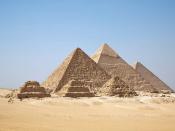In the Age of the pyramids, also known as the Old Kingdom, the history of man's most incredible accomplishments are substantial. However, none of these accomplishments can match the magnitude of the engineering and organizational genius that was present in the construction of the Great Pyramid of Giza. Egyptian pyramids are the world's oldest massive stone monuments and have the power to inflame the imagination. This monument is one of the most awesome examples of man's structural ability. "Being the oldest structures on the face of the earth, and best built, and most accurately oriented, we could not build this pyramid today"ÃÂ (The Great Pyramids online). The Great Pyramid, is still regarded as one of the Seven Wonders of the World, and continues to mystify us. The unanswered questions regarding the Egyptian monuments are endless but no questions have been the object of as much speculation as the question regarding the method construction.
The Great Pyramid was constructed for King Khufu (Cheops) more than 4,500 years ago in the Fourth Dynasty (2528 B.C.) The pyramid rose to a height of 482 feet. It was the tallest structure in the world until the 19th century. An area of 756 square feet was the pyramid base. It was almost a perfect square. The difference in length between the longest of the four square sides are less than seven point nine inches. The Egyptians were off of alignment on the four sides only by a fraction of a degree. The northern side of the pyramid veered from the southern by just one inch. The pyramid covered thirteen point one acres and is equal to seven city blocks. The building of the pyramid consisted of placing two point three million blocks over a twenty-year period. The blocks weighed from two point five to...


